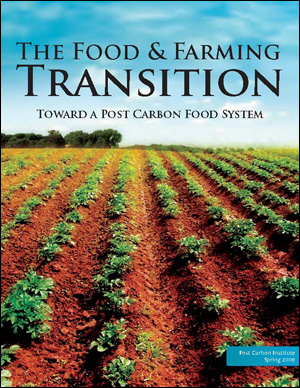
The Food and Farming Transition: Toward a Post Carbon Food System
Michael Bomford Richard Heinberg
March 30, 2009
How can we continue feeding humanity in a future of declining resources and environmental crisis? This report explores the growing vulnerabilities of the current food system, and the steps needed to transition to a post-carbon food system.
Summary
The American food system rests on an unstable foundation of massive fossil fuel inputs. It must be reinvented in the face of declining fuel stocks. The new food system will use less energy, and the energy it uses will come from renewable sources. We can begin the transition to the new system immediately through a process of planned, graduated, rapid change. The unplanned alternative-reconstruction from scratch after collapse-would be chaotic and tragic.
The seeds of the new food system have already been planted. America’s farmers have been reducing their energy use for decades. They are using less fertilizer and pesticide. The number of organic farms, farmers’ markets, and community-supported-agriculture (CSA) operations is growing rapidly. More people are thinking about where their food comes from.
These are important building blocks, but much remains to be done. Our new food system will require more farmers, smaller and more diversified farms, less processed and packaged food, and less long-distance hauling of food. Governments, communities, businesses, and families each have important parts to play in reinventing a food system that functions with limited renewable energy resources to feed our population for the long term.
Translations
» Italian / Italiano (by volunteers from Transition Italia, ASPO Italia, and Circolo MDF Roma)
» Albanian / Shqip (by volunteer Rita Strakosha)
» Spanish / Español (by volunteer Carlos Valmaseda)
» Turkish
